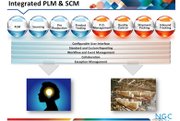When to Make the Switch to PLM
With the increase of fast fashion, apparel companies are under increasing pressure to provide more lines, more quickly, which can mean chaos for a company that isn’t prepared to deal with the increased workflow.
“Retailers are requiring wider assortments, and instead of three items, now they want 23 items and a bunch of styles, a bunch of colors and many size ranges,” said Mark Burstein, president of sales, marketing, and research and development for NGC Software. “They’re looking to the brand to offer them a lot of options that they can select from, and they want them to show these items more often than they used to. In the past, there were two seasons: Spring and Fall. Now they expect a lot of different lines and faster—from the time [a brand] shows them a line to the time the goods are delivered has shrunk.”
Speed to market has become a challenge for many apparel companies. Spanish retailer Zara—which is reportedly able to turn goods from concept to shelf in two to three weeks—helped initiate the speed-to-market push starting about five or six years ago, Burstein said.
“What happens is that these companies are finding it impossible to keep up with this pace regardless of the amount of man hours being worked,” Burstein said. “As a result, companies that cannot keep up the pace will lose their customers to other competitors, and their staff will burn out.”
Tools such as spreadsheets, Adobe Illustrator, SharePoint, product data-management tech packs and email can work well for companies handling smaller work orders, but often mid- to large-sized apparel companies need a more sophisticated and unified system to keep their workflow organized.
Missing information
If a company finds that information is falling through the cracks, that is one of the signs that the company is ready to graduate to PLM, Burstein said.
Errors, missed deadlines, and losing communication between designers, manufacturers and production people means the company’s current system isn’t working, he explained. For example, when an order is revised and it’s never communicated to the factory, so the goods are made incorrectly.
“The other thing that they notice is that their calendars [for events, production and fit approval] are consistently running late because they find out about a problem at the last minute rather than proactively trying to be ahead of problems,” he said.
Delays—from the inability to answer questions to not having any idea how much time is going into the creation of product, not having certainty on product adoption rates and a complete lack of control over the data—also signify that it’s time to upgrade, said Robert McKee, fashion-industry strategy director for Lawson.
“When it takes longer to answer a question about what’s going on in the product’s lifecycle than the product is going to have in its lifecycle, it’s time to change,” McKee said.
Struggling with record keeping can also serve as an indicator that the company is ready for a change.
“There’s a boatload of compliance requirements—not just international but also state and local,” he said. “What about the issues of sustainability? Do you have your record keeping all filed in a way that you can justify your decisions if you’re asked to?”
Trouble staying on top of workflow
If the staff feels that they are constantly running behind schedule no matter how many hours they work, that’s a sure sign they’re ready for an upgrade to PLM, Burstein said.
“From an owner’s perspective, they can see the company isn’t performing the way it needs to or the way they expect it to, and from the staff’s perspective, they’re constantly working and they can’t accomplish their goals in a timely manner,” he explained.
Robbie Pannell, products applications support specialist at golf-apparel retailer Cutter & Buck, listed some of the ways staff may be bogged down:
•“Designers and tech designers are spending hours of their day creating and updating tracking charts for management.
•“Management has to ask for the status of everything instead of looking in a central mainframe or running reports themselves.
•“Designers have to request lab-dip and testing status of materials for their styles instead of looking in a central place.
•“Tech designers are sending countless emails each day with fit comments; spreadsheets are continuously getting out of date.”
Communication and collaboration is very important both within a company and with its suppliers, and when it’s not happening quickly enough or accurately enough, a company quickly falls behind, said Lenny Weiss, North America sales manager for Yunique PLM.
“A company realizes at one point that they’re not getting their info quick enough to management or suppliers and it takes too long, and when that happens, problems multiply,” he said. “Once you’re behind and trying to make that up, it’s more difficult. … Speed to market is so important. You can’t compete without getting to market quickly, properly and accurately.”
Size matters
PLM becomes a useful tool for an organization that has at least three designers and is doing business with at least 10 vendors, Burstein said.
“Once it reaches this size it becomes very difficult to manage product lifecycle management using email and spreadsheets, and they need to be on a system,” he said.
When a company is large enough that it exhibits an inability to manage its development, sourcing, compliance, or sustainability cycles and requirements, it’s time to upgrade, McKee said.
“But if you can’t find a difference between your current PDM approach and a new PLM system, don’t buy it. It’s insufficient to your needs,” he said.
Shrinking profit margins
When executives start noticing that they used to make a 30 percent profit margin on a particular style, but their profit is dropping due to unanticipated costs during the production cycle and now they’re only making 15 percent profit, that could be a sign that it is time to implement a PLM system, Burstein said.
Having the wrong system can result in problems such as paying for air freight because factory goods are running late, which can quickly eat into a company’s profit, he explained.
When a company is ready to grow
Another sign that a company is ready for PLM is when they are thinking of growing, Weiss said.
“When a company wants to grow, if you don’t have the right systems in place, you stymie your growth rate, so you can’t grow fast enough,” he said. “But if you have the right systems in place, the system [rather than the staff] is bearing the brunt. We never talk to a customer about reducing people. We tell them that as they grow, they won’t have to add people.”
Brian Snyder, director of global apparel operations at Wolverine World Wide, which recently adopted Yunique’s PLM, said that legacy data can also play into the decision.
“You have to look at the size of your business and the amount of legacy data [previous seasons of development] that you maintain. In our case, we only had three or four years’ worth of data, and there was a lot of it that we felt was obsolete, so it wasn’t a huge challenge for us. But for some companies it will be.”
The benefits of PLM
Some of the benefits of PLM include saving time through the “enter once, use many” data approach, McKee said.
Snyder agreed.
“I would say that the most immediate improvement was multiple points of data entry became a single point of data entry,” he said. “When we want to create a line plan, there is basically one source that we go to to generate all of that data, and that’s the same source that we communicate to our sourcing partners. It’s not a separate spreadsheet; everything comes from one data source—one version of the truth—which prevents errors and miscommunications.”
Other benefits include the time saved from physical faxing, emailing and air freighting, McKee added.
“If we look at the traditional concept, development, production and delivery cycle of a product in the old sewn-products industry, we’d be looking at an anticipated cycle of 18 months. Today, with the deployment of systems like PLM and ERP [enterprise resource planning]—we’re seeing those old cycle times cut to times more like 18 weeks,” he said.
Cutter & Buck is also using Yunique’s PLM system, which Pannell says has provided a “one-stop shop” for all of his company’s product data to live.
“Product line directors are able to see what is going on with their styles at all times—whether it’s down at the lab-dip level or at the production sample level. It has streamlined communication with our overseas partners by allowing us to share tech packs through the system, which has reduced the amount of email we’ve had to send,” he said. “It has helped a great deal with change management. Being able to look back at previous versions of CADs is very helpful, as is seeing all of a style’s sample comments in one central repository.”
The PLM system can create instant, current tracking reports and filter them depending on the user. Employees can log in from anywhere in the world to check on the status of styles and update comments.
Pannell described the “visibility” provided by the system as “invaluable and awesome.”

























